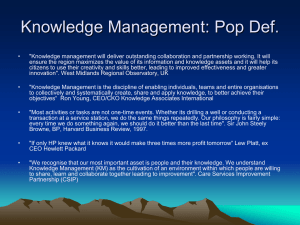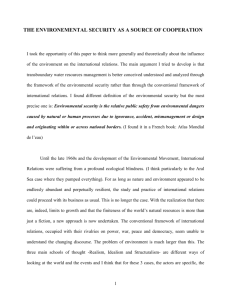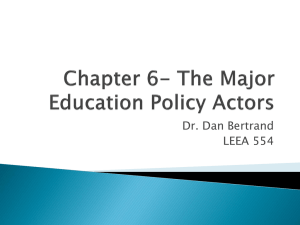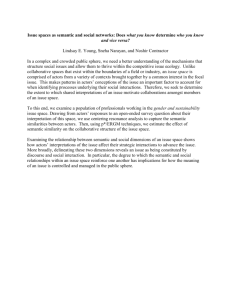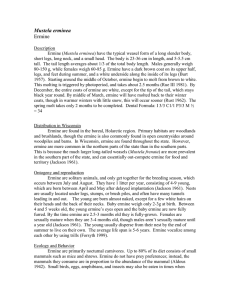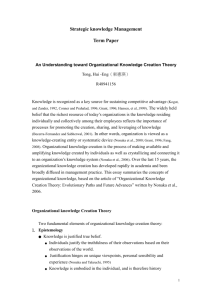2. Formal model for KMS
advertisement
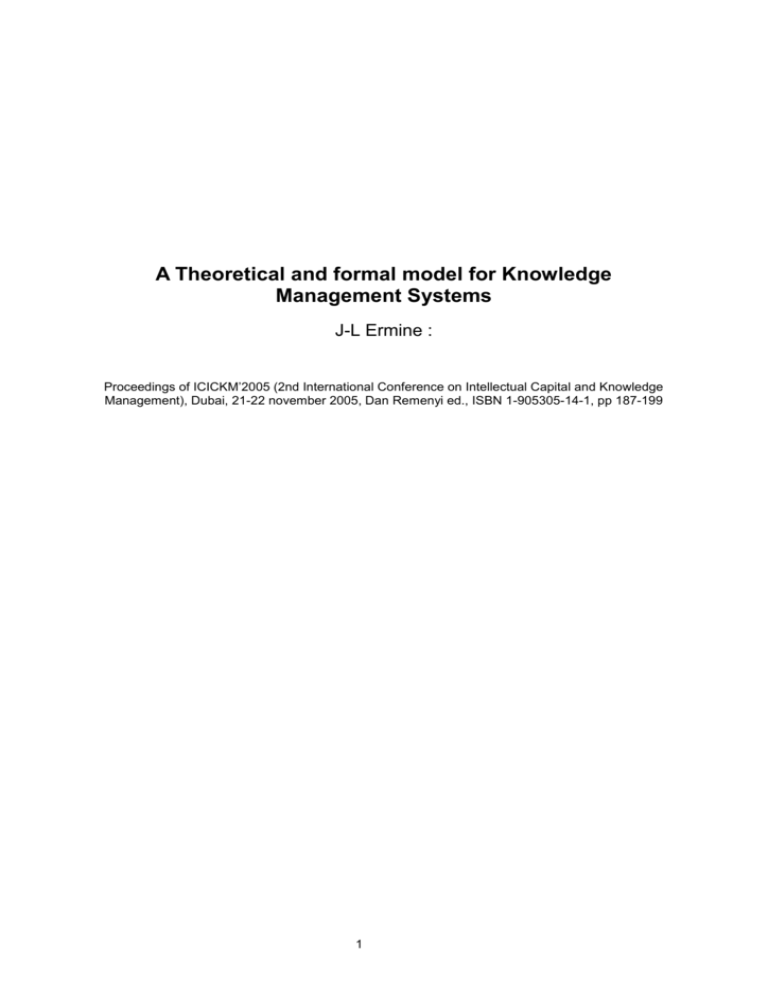
A Theoretical and formal model for Knowledge Management Systems J-L Ermine : Proceedings of ICICKM’2005 (2nd International Conference on Intellectual Capital and Knowledge Management), Dubai, 21-22 november 2005, Dan Remenyi ed., ISBN 1-905305-14-1, pp 187-199 1 A Theoretical and Management Systems Formal Model for Knowledge Jean-Louis Ermine Institut National des Télécommunications 9 Rue Charles Fourier, 91011 EVRY Cedex, France jean-louis.ermine@int-evry.fr Abstract: Knowledge management is now a huge domain, where it is difficult to have a clear view of the manipulated concepts and their crossed-relations. The development of that domain requires now a theoretical framework including concepts from various theories as Knowledge Economy, Information Systems, Knowledge theories (in particular Nonaka’s theory), Communities of practice (Wenger’s theory), General System Theory, Semiotic, Information theory, Knowledge Worker concept …This paper is an attempt to provide sound basis for such a framework, with a mathematical formalism. The formalism is inspired by the one used in Information System Theory, based on General System Theory (OID Model). The proposed model is structured by the set of networks (or communities) of Knowledge Workers, A, the Information System, I, and the Knowledge Capital, K (AIK model). Different morphisms, functions and operators provide classical KM links (or knowledge flows) and KM combinations for those subsystems. Keywords: Knowledge Theories, KM Framework, KM Formalism 1. Introduction 1.1 Foreword Knowledge Management (KM) is now a domain in full expansion. It is not easy to design formal and theoretical framework for that domain that involves the economic, but also social and cultural, world. The genesis of such a domain is complex. It comes from economy, management, social sciences, information systems, information technology etc. To constitute a coherent disciplinary corpus is not simple. We tempt to rely, in a common package, concepts from USA, Japan, and France, that permitted to our teams, during fifteen years of applied research, in different laboratories, to achieve some very various innovating applications in various enterprises and organizations, and, at the same time, to lead some consequent research in this domain. Our goal is to provide a framework that is both formal (hence the choice of mathematics as description language) and theoretical (since it is based on theories and ideas that strongly influenced KM during these last fifteen years). The Knowledge Theories are very sound and developed; we will remind them very briefly. The formalism may seem a little arduous, but it is rather unambiguous, and strictly represents (even though only partially) the evoked theories. The bibliography is very short, voluntarily. Most the quoted references are often fundamental, and to trace their quotes will be sufficient to accumulate a representative bibliography of the domain, as a domain of engineering and management. The objective of this work is not to present new things in KM, but to federate ideas that have all brought a main contribution to the domain. 1.2 Knowledge Workers The term « Knowledge Worker » is not a very new notion, since it was coined in 1959, by Peter Drucker ([Drucker 59]). This term designates anyone involved in tasks in which one develops or uses knowledge. If one understands the knowledge worker as the person that creates, applies, transmits and/or acquires knowledge, it seems that everybody maybe concerned. Then, the problem becomes more to establish conditions to improve this work, in a given strategic context, by identification and development of capacities, incentives and opportunities than to identify who achieves the tasks! Jean-Louis Ermine 1.3 The tacit and explicit knowledge theory We refer to the theory of Nonaka and Takeuchi, ([Nonaka 95]) that strongly influenced nearly all KM researches and approaches. This theory distinguishes two types of knowledge: explicit knowledge and tacit knowledge. According to this theory, there exist four modes of conversion between tacit and explicit knowledge (designated with the SECI acronym): *) Socialization, from tacit knowledge to tacit knowledge (learning by observing and doing, face to face training…) *) Externalisation, from tacit knowledge to explicit knowledge (metaphors, concepts, hypotheses, models, analogies, transcription…). *) Combination of explicit knowledge consisting in rearraging pieces of explicit knowledge to build new explicit knowledge *) Internalisation, from explicit knowledge to tacit knowledge, where explicit knowledge disseminated in the organization is assimilated by individuals that become richer of new knowledge. 1.4 The Knowledge Economy Knowledge Economy is a notion that was highlighted in Europe by the Lisboa declaration and process, in 2000 that aim to make European Union «the most competitive and most dynamic Knowledge Economy, capable of a sustainable economic growth, together with a quantitative and qualitative improvement of employment, and a bigger social cohesion». Apart from the political discourse, this declaration is based on an analysis of the society evolution where converge two heavy factors: the increase of resources dedicated to production and transmission of knowledge, and the tremendous development of ICT. To have a sound approach of thet concept of “Knwoledge based Economy”, Dominique Foray and an international team have just finished a large innovating survey at OECD, concerning 9 industrialized countries (Australia, Canada, Denmark, France, Germany, Ireland, Italy, Netherlands, Sweden), with nearly 10 000 enterprises, that shows interrelationship between KM practices and enterprise performance ([OECD 2004]). 1.5 Communities of Practice The concept of Community of Practice has been coined by the anthropologist Jean Lave and Etienne Wenger in 1991 when studying situating learning as a general training model ([Lava 91]).([Wenger 98]). Communities of practice are people groups that share an interest or a passion for something they make, and learn to make it better by interacting. A community of practice is characterized by a common interest domain that distinguishes the members from other people. Its members construct relations that allow them to learn from each other. They are practitioners who develop shared resources to improve their practices. 1.6 General System Theory and Complex Thinking The General System Theory (GTS), popularized in France by the famous works of Jean-Louis Le Moigne ([Le Moigne 77] and [Le Moigne 90]), is a rupture with the traditional vision of the analytic method, used in science since Descartes. This rupture is due to the fact that most of the present problems are essentially related to “complex systems” in a sense which is now extensively accepted. Complexity, in the sense of systems or thinking, (Edgar Morin is one of the leader of “Complex Thinking” [Morin 90]) is now a new philosophical and scientific paradigm. Complexity applies also to Knowledge Theory, after the fundamental Edgar Morin’s book, “La connaissance de la connaissance” (“Knowledge of Knowledge”), included in his huge masterwork “La Méthode”. The systemic method of the GTS, complementary to the analytic method, can bring some elements to complex thinking and complex systems. Usually, a general system is composed of an Operating system, an Information system, and a Decision system (OID model). This modelling is largely used in enterprises and organizations: the operating system is constituted by actors that transform flows of energy, matter or information, in other flows of the same nature; this is the basic business process of the enterprise. The information system is constituted by anything that stocks, memorizes and displays information. This information system informs managers that make decision to supervise the production process, via the operating system. This model permits to describe any general system. For KM purpose, this model evolved somewhat ([Ermine 2000]). The proven existence of a Knowledge Capital, proper to the organisation, justifies the hypothesis of the existence of a fourth subsystem that one will call “Knowledge Capital” (or “Knowledge System”). This subsystem is clearly an active system. It possesses the two fundamental activities defined by Edgar Morin ([Morin 86], Introduction): the activity of produced knowledge acquisition, and the activity of cognition, related to the transmission of this knowledge. These activities generate flows (cognitive flows) that create some active interrelationships with the other subsystems of the system : those, that leave from subsystems toward the knowledge system, correspond, according to the appellation of Morin Edgar, to activities of competence (knowledge production), and those, that leave from the knowledge system toward the other subsystems, correspond to activities of cognition. The competence flow corresponds to the enrichment (through time) of the knowledge capital of the system, via the different human actors or components (physical objects, systems of information...). The cognition flow corresponds to the appropriation, implicit (the most often) or explicit, of this capital in order to use it in the production process of the system. 1.7 The Knowledge Macroscope Theory The Knowledge Macroscope Theory is a conceptual tool to structure the Knowledge Capital of an organised system. It is described and justified in [Ermine 2000], and has been made operational through a Knowledge Engineering method, called MASK, that has been used in dozens of real projects, sometimes very large-scale. Two hypotheses are given for the definition of what is knowledge according to the macroscope. The first one is the semiotic hypothesis. According to semiotic science, knowledge is defined as a sign, composed of information (the codification of the sign), sense (the representation generated by the sign information to make sense), and context (the environment that gives sense to the sign). The typical example is the one of a watch, which communicates coded information (and in fact, the code is extremely complex to analyse), which takes some very various significances (the basic one is time!), these significances depending on situations and potentially infinite contexts (appointment, timetables, experiences, process supervision, scheduling….). The second hypothesis is the systemic hypothesis. According to General System Theory, knowledge is defined as a general system with always three points of view: structure, function and evolution. To describe a watch one can describe its function (to say what time it is…), its structure (shape, mechanism, design etc.), its position in the evolution of watches (electric or mechanical, digital, with needles or liquid crystals, fashion period etc.). To analyze the knowledge, it is therefore to describe it through this set of points of views: information, sense, context on the one hand, structure, function, evolution on the other hand. 2. Formal model for KMS (AIK model) 2.1 Notations S: Knowledge Management System (KMS) A: set of knowledge actors (Knowledge Workers) in an organisation A: P (A) set of subsets of A I: Information System (IS) K: Knowledge Capital val: any valuation function R val : K where R is the set of real numbers Properties: A S I S 2.2 The Edgar Morin’s functions The cognition function: cog : K S Jean-Louis Ermine Property: The cognition function represents the appropriation of the Knowledge Capital by the KMS We have: A Im(cog) (knowledge actors utilise the Knowledge Capital) The competence function : comp : S K Property : The competence function represents the knowledge contribution of the KMS to the Capital We have: A Dom(comp) (knowledge actors bring knowledge to the Knowledge Capital) The definition domain of comp is not restricted to A, other subsystems detain knowledge (the technical devices, bases of information…), and generate competence for K. Definition : comp o cog is called the canonical function of S. This function represents usage cycle of the knowledge in S. Knowledge in K is used by S, and its use generates competence in K. One of fundamental characteristic of knowledge, according to the economic theory, is to be cumulative («knowledge is the main factor of the new knowledge production» [Foray 2000], chap. V). A KMS must respect this property; it must transform knowledge while bringing some added value. This can be expressed thanks to the valuation function, with the following axiom, which is the fundamental property of a KMS: Axiom: The KMS canonical function is an increasing function of the valuation function: k K, val(comp o cog(k)) val(k) 2.3 Wenger’s operator w : A A (a,a’) A a w a’ This operator represents the aggregation of actors in knowledge communities. It is an operator that is the set-theoretic union operator's restriction to the subset of A composed by knowledge networks. Conditions of aggregation, provided by Wenger, may give more precise definition for this operator. 2.4 Nonaka’s operators Combination operator c : I I (i,i’) I i c i’ This operator represents the combination of information that may achieve an actor, especially within an information system. s : Socialisation operator K K (k,k’) K k s k’ This operator represents the combination of knowledge through networks of knowledge actors, as shown in the property below. Property: The competence function has a morphism property for the Wenger’s and socialisation operators: comp(a w a’) = comp(a) s comp(a’) This property means that two actors in a knowledge community generate competence in K by combining their knowledge, in the sense of socialisation.The cognition function has no such property. Knowledge appropriation in a knowledge community doesn’t correspond to combination of the knowledge appropriated by the actors. 2.5 Knowledge actors’ functions The expression function : expr : A I It represents the inscription of the actors’ knowledge in the IS. The appropriation function: appr : I A It represents the transformation, by an actor, of information into knowledge. Property: The expression function has a morphism property for the Wenger’s and combination operators: expr(a w a’) = expr(a) c expr(a’) The appropriation function has no such property. We don’t see either how a collective knowledge is built by aggregating individual knowledge. 2.6 Nonaka’s functions The externalisation function: ext : K I It represents the transformation of knowledge into information. The internalisation function: int : I K It represents the transformation of information into knowledge. Definition : The set of explicit (« explicitable ») knowledge is the set : Ke = comp(A) ext -1 (Im(ext)) The knowledge of explicit type is knowledge produced by networks of knowledge actors that can be converted in information. In general, one often means by explicit knowledge clarify a strict subset of this set, without giving the precise definition ( “elicited” knowledge, image of the function ext, at a given moment; this introduces a notion of time, that is not, up to now, in the proposed model). The set of tacit knowledge is the set: Kt = comp(A) Κe Knowledge of tacit type is knowledge produced by networks of actors that are not explicit (either elicited or “explicitable”). Jean-Louis Ermine Properties : The following diagrams are commutative : ext K I cog expr A ext = expr o cog (Externalisation consists, for an actor, in expressing in the IS, the knowledge appropriated in K) int I K appr comp A int = comp o appr (Internalisation consists, for an actor, in bringing in K, the knowledge appropriated via the IS) 2.7 Systemic diagram of a KMS Figure 1 graphically represents, in a synthetic manner, the proposed model. S expr w c A appr comp cog s K val R Figure 1 : The graphical diagram of a KMS ext int I 3. Relations between the AIK and the OID models of a system. 3.1 Introduction In the AIK model, actors of A are decision actors as well as operating actors, or both. In the first case they are detaining “decisional knowledge” (cf. decision making theory), in the second of knowledge of “operational knowledge”. In relation to the classic finality of a system, which is the transformation of flow through the production process, the theory the Knowledge Economy [Foray 2000], the function of production generates a socalled « joint product » that is the knowledge that accumulates in the knowledge capital of the system. While producing goods and services, that are the prime finality of an enterprise, the organization, in a non-planned manner, is in a learning process (provoked by the apparition of non anticipated, or unsolved problems), that produces new skills, new knowledge This joint production, ignored up to now because considered as a side-effect and non strategic, prove to be henceforth fundamental and is the concern of KM. 3.2 Decisional, operational knowledge and joint production D dec S A comp I cog op O K prod Figure 2 : Relations between AIK and OID models To visualise the link between the AIK and OID models we define the canonical injections: op : A O dec : A D (a knowledge actor may be in the Operating system and/or in the Decision system The subset of K: Im (comp o dec-1) is called the decisional knowledge, and the subset of K : Im (comp o op-1) is called the operational knowledge. Let E the environment of the system, which contains the in and out flows. The transformation function of the system (of in-flows into out-flows), called production function, is a function: prod : E O I D E The functions of « joint production » for knowledge are : - comp o op-1 o PO o prod-1 Jean-Louis Ermine - comp o dec-1 o PD o prod-1 where PO and PD are the canonical projections from E O I D to O and D. The interaction between the AIK and OID models is synthesised in the diagram in figure 2. 4. Equivalence between Nonaka’s theory and Wenger’s theory 4.1 Introduction The Nonaka’s SECI process (Socialisation, Externalisation, Combination, Internalisation) is the process (or processes) of knowledge transformation of in an organisation. It defines transformations between knowledge and information, therefore functions between K and I. If of course actors are deeply involved in these transformations, they don't intervene in the model. It is probably the first time that one manipulates, in a model, the knowledge itself, and not like a « side effect » resulting of networks and social interactions. The Wenger’s theory of communities doesn't address directly the problem of knowledge, the roles of actors, their organisations and their functioning modes. KM applications of these concepts greatly rely on devices including information systems. It is therefore an « indirect KM» knowledge management, performed via interactions between knowledge actors and information systems. The link between these two theories, if it seems intuitive, is rarely addressed. The proposed model provides here a relation that is rather obvious, and that is mathematically « fundamental », what proves a strong and sound link. There is equivalence between externalisation and expression, internalisation and appropriation. The equivalence is sound if the use of the IS by knowledge actors always allows the KMS to produce added value for knowledge. Intuitively, this appears very natural! 4.2 Equivalence between the tacit/implicit knowledge approach and the knowledge community approach In the AIK model, the SECI process is represented by the following Nonaka diagram (which is not a fully functional diagram!): c I I ext int Ke Kt s Ke Kt where Ke Kt = comp(A) If the socialisation operator represents the « direct knowledge transfer”, in that Nonaka diagram, the correspondence: Int o c o ext = TriK represents the « indirect knowledge transfer ». One can relate this diagram with the following diagram, from the AIK model (knowledge communities diagram or Wenger diagram): c I I expr appr w A A The correspondence: (appr o c o expr) = TriA represents the “indirect transfer” between knowledge actors. In the Nonaka diagram, due to the properties of int and ext, the correspondence “indirect knowledge transfer” is equal to : comp o (appr o c o expr) o cog = TriK So we have: TriK = comp o TriA o cog The indirect knowledge transfer in the Nonaka process is therefore « similar » to the canonical function of S, modulo the indirect transfer of knowledge between actors Tri A ( TriK and TriA are called, in mathematics, “congruent” functions). One can think therefore about to replace the canonical function (competence/cognition) of S by the new canonical function Tri K (externalisation/combination/internalisation), and to get a restricted theory (to knowledge actors) of Knowledge Management Systems. For that, it is sufficient that the correspondence Tri A preserves the growth of the canonical function with respect to the valuation function, that is to say: k K, val(comp o cog(k)) val(k) val(comp o TriA o cog(k)) val(k) It means intuitively that if one wants a theory of KMS coherent with the Nonaka’s theory , it is sufficient, in S, to have operations of expression, of combinations of information, of appropriation that participates in bringing the added value to the Knowledge Capital. Therefore, one replaces an external property on S by an internal property on S, via knowledge actors. 5. A first example of value function 5.1 Introduction To define a valuation function for the AIK model can be done in multiple ways. The first idea is to define an “economy type” function, estimating financially the value of a knowledge capital. This the attempt of a great number of research based on Intellectual Capital (see ([Evindson 99], [Stewart 97], [Strassman 99] [Sveiby 98] for instance). A second idea, is to give a « grade » on a maturity scale to a knowledge map of K, that permits to value qualitatively and (a few) quantitatively the Knowledge Capital, in order to build a KM strategy for optimising the added value (see [Aubertin 2005], for instance). The proposition that we make in this paragraph is fully quantitative. It tries to estimate the « knowledge quantity » contained in a given knowledge corpus. The idea could appear odd, but it has a famous precedent, that is the measure of the information quantity in a given information corpus. This measure relies on a theory elaborated by Shannon, and has a quantity unit: the bit (binary digit). Is it possible then to define such a type of measure not for information, but for knowledge? First, it is necessary to make clear the link between information and knowledge. This is made in the macroscope theory described in [Ermine 2000]. That is only a specific approach of knowledge, but that we will keep here. Roughly speaking, knowledge is information that takes sense, in a given context. If the notion of information is clear, (referring to Shannon’s theory), the notion of sense, and moreover of context, is far less clear. It is necessary to give interpretations therefore « measurable » of what can be the sense or the context. This is not certainly an easy task. We are going to make some first propositions in this direction. A full research program, with a detailed theory, experiments and test is currently in progress on that subject. If the program to make a Shannon’s theory for knowledge (the theory of the kit (knowledge unit)) seems ambitious, we provide elements that can be submitted to critique, improved and refuted in Jean-Louis Ermine order to get closer to such a theory. If this theory existed, applications that one can imagine would be innumerable. 5.2 Quantity of knowledge According to the semiotic theory used in [Ermine 2000], knowledge can be analyzed according to three points of views identified to information, sense and context. Let I the information space, Se the sense space, Co the context space, we have: K = I Se Co k K, i I, s Se , c Co : k = (i,s,c) Then, for k K, we can define three real-valued evaluation functions : ValI : R I ValS : Se R ValC : Co R that evaluate respectively the information, the semantic value and the contextual value of a piece of knowledge. The global value is a function of those three values: Val(k) = F(ValI (k), ValS (k), ValC (k)) We can compute a « limited development » of the F function that we will stop at order one, and simplify by vanishing the residual term: Val(H) = ValI(H) ValS(H) ValC(H) + o(H) Then, for k K, we define: Val(k) = ValI(k) ValS(k) ValC(k) This defines a quantitative value function for knowledge, as far as we can define: *) the operator . We can choose, for instance, multiplication *) ValI(k), which is the measure of the information enclosed in k. This is a well-known measure in the Shannon’s theory that can be given in bits (binary digits). If, for instance, k is materialised by an digital information basis (document basis, database …), its informational measure is given in bits, kilo or mega bytes. *) ValS(k), which is the measure of the semantic complexity of k. In linguistics, the elementary unit of sense is called “seme”. Usually sense is represented as a graph of semes (a semantic network, for instance). Then, the sense enclosed in a knowledge corpus can be measured from a graph of semes. Graph theory provides measures for the complexity of that graph. Let’s take an example : a knowledge corpus is materialised in a document corpus. There exist numerous techniques, algorithms, software … for extracting a significant graph terms (text mining, Condorcet algorithms, co-occurrence algorithms …). This graph is, in a way, the representation of the semantic of the corpus. Let Γ(k) such a graph. Let m a complexity measure for a graph (for instance, the minimal number of vertices to erase to get a tree)., m(Γ(k)) can be considered as the measure of the semantic complexity of the corpus. *) ValC(k), which is the contextual complexity of k. To try a first approach in this totally new field of research, we can assume that the contextual value is the usage value: the usage of a given knowledge by a community determines its contextual value. Let’s take a very simple example: a knowledge corpus (document corpus) is available for a knowledge community, via a web site. The usage value can be, in a very simple approach (but do we know more?), by the number of hits of the web site, N(k) (k has no context value if nobody is connected to the site!). Then, for a knowledge corpus, materialised by a document corpus, available on a web site, we can define a measure for the enclosed knowledge with the formula: Val(k) = inf(k) . m(Γ(k)) . N(k) Val(k) is expressed in “kit” (“knowledge unit”). We will need a lot of studies and experiments to define a pertinent value for the kit ! A research program is in progress on that subject. 6. Conclusion This article gives a formal model of a Knowledge Management System (KMS) that means a system that manages the Knowledge Capital of an organization, related to a classical formal model for Information System. The “heart” of the KMS is formed by networks of knowledge actors (knowledge workers) in relation with the information system (IS). This relation is defined by flows exchanged between these two systems: the « expression » flow (actors express themselves while managing information captured by the IS) and the « appropriation » flow (actors appropriate information of the IS to transform it into knowledge, i.e. it makes sense for them in their operational context). This « heart » of the KMS is included in a larger system that represents the organized system. This organized system possesses a Knowledge Capital, with which it exchanges flows of cognition and competence. These flows of competence and cognition are the prime components of the KMS canonical function. The notion of added value through knowledge production is fundamental in KM. It is represented in the model by a valuation function, real-valued, defined on the Knowledge Capital. If this representation is simple, to define such a function is not easy. It may exist several function of different nature, depending on the nature of the considered problematic (strategic, economic, technique etc.). We have given here an idea of how to build a quantitative function of knowledge in the Shannon’s theory way. The set of networks of knowledge actors may be seen, at least partly, as the set of communities of practice in the Wenger’s sense. One will generally speak of knowledge communities. The constitution of knowledge communities is an important problem in KM. One will represent it in the model by an operator of aggregation between networks of actors (a network can even be constituted of one people!), which is the set-theoretic union operator's restriction, called Wenger’s operator. The Nonaka’s theory is included in the framework. The proposed model establishes the link between this theory and the IS or the Wenger’s theory, by considering that explicit knowledge are mappings in the IS of elements of the Knowledge Capital, that tacit knowledge are mappings of actors’ competences in the Knowledge Capital. In this last case the socialization of knowledge is equivalent to the aggregation of the actors’ competences via the Wenger’s operator. Next issue of the model is to integrate different new point of views: knowledge cartography, critical knowledge factors, and topoly of the knowledge space. A Shannon theory of knowledge is also likely to be integrated. 7. Références [Aubertin 2005] : Aubertin G. : Knowledge mapping: a strategic entry point to knowledge management in « Trends in Applied Knowledge Management », Hermes Penton, 2005, to appear Jean-Louis Ermine [Ermine 2000] Ermine J.-L. (2000). Les systèmes de connaissances, Hermes sciences publications, Paris, 1996, deuxième édition 2000 (In French) [Foray 2000] Foray D. : L’économie de la connaissance, Repères n°302, La Découverte, 2000 (In French, English version available). [Lave 91] Lave A., Wenger E. : Situating learning, legitimate peripherical participation, Cambridge University Press, 1991 [Le Moigne 77] Le Moigne J-L : La théorie du Système Général, théorie de la modélisation, P.U.F., Paris, 1977, 3ième édition mise à jour, 1990 (in French, English version available) [Le Moigne 90] Le Moigne J-L : La modélisation des systèmes complexes, Afcet Systèmes, Dunod, Paris, 1990 (in French) [Morin 86] Morin E. : La méthode, 3. La connaissance de la connaissance, Editions du seuil, Paris, 1986 (in French) [Morin 90] Morin E. : Introduction à la pensée complexe, Communication et complexité, ESF éd., Paris, 1990 (in French) [Nonaka 95] Nonaka I., Takeuchi H. : The Knowledge-Creating Company, Oxford University Press, 1995 [Strassman 99] STRASSMANN P., Calculating Knowledge Capital, Knowledge Management Magazine (October), http://files.strassmann.com/pubs/km/1999-10.pp, 1999 [Sveiby 98] SVEIBY K-E., Intellectual Capital: thinking ahead, Australian CPA, vol.68, n°5, p 18-22, June 1998 [Stewart 97] Stewart T : Intellectual Capital, the New Wealth of Organizations, Currency/Doubleday., New York, 1997 [ODCE 2004] Gestion des connaissances : mesurer la gestion des connaissances dans le secteur commercial, premiers résultats, Publications de l’OCDE, 2004 (in French and English) [Wenger 98] Wenger E.: Communities of Practice : Learning, Meaning and Identity, New York, Cambridge University Press, 1998 [ Drucker 59 ] Drucker P. : Landmarks of Tomorrow, Harper and Brothers, New York, 1959 Jean-Louis Ermine obtains a Phd in pure mathematics at the University Denis Diderot of Paris in 1976, and a National Research Director Title in computer science in 1990 at the University of Bordeaux. During more than ten years, he makes research in mathematics, on algebraic geometry applied to functions of several complex variables. In 1985, he switches to Artificial Intelligence. In 1991, he joins the French Atomic Energy Commission (CEA) in Saclay, near Paris, where he is responsible of a postgraduate diploma in computer science, in collaboration with Paris Sud University (Orsay). In 1994, he is responsible of the Knowledge Management Group in CEA, until 2000. In 2003, he joins the “Institut National des Télécommunications” as head of the Information Systems Department, to develop research end teaching activities in Knowledge Management. Jean-Louis Ermine is the inventor of the MASK method, a Knowledge Management methodology used in CEA and in a lot of French and foreign companies since 1993. He has written more than 50 scientific articles and four books on Knowledge Management and Engineering. He was nominated as “CEA senior expert” in 1996, and “CEA expert consultant” for external companies in 1997. Since 2002, he acts as a KM expert of the UN/IAEA (International Atomic Energy Agency). In 1999, he founded the French Knowledge Management Club, an association rallying a lot of French companies. He is now the president of that club.


